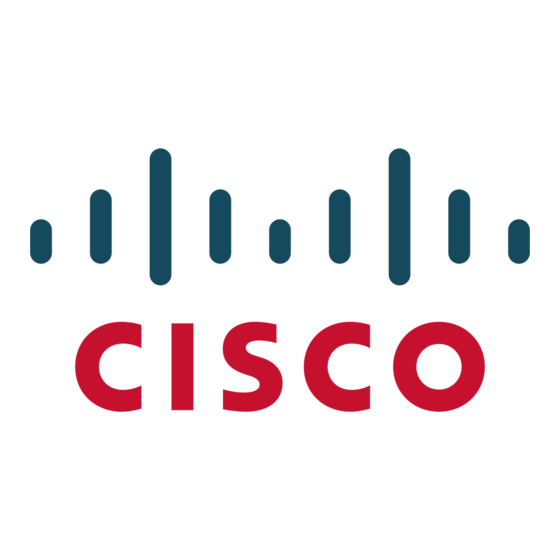Cisco C-series Nexus 5020 Технічні характеристики - Сторінка 2
Переглянути онлайн або завантажити pdf Технічні характеристики для Перемикач Cisco C-series Nexus 5020. Cisco C-series Nexus 5020 3 сторінки. Replacing an i/o module nexus 5000 series
Також для Cisco C-series Nexus 5020: Технічний паспорт (23 сторінок), Примітка до випуску (26 сторінок), Примітка до випуску (3 сторінок), Посібник (11 сторінок), Посібник з встановлення обладнання (19 сторінок)

Cisco Nexus 5000 Series Switches
•
Operational manageability
- Simpler, more resilient Layer 2 and 3 networks
- Preservation of management best practices
•
Transport flexibility
- End-to-end FCoE-based converged fabric
- Fibre Channel
- Virtual machine–optimized services
- Lossless Ethernet service with no-drop flow control
•
Infrastructure scalability
- Reduced power and cooling demands
- Nonblocking capacity of approximately 2 terabits per
second (Tbps)
Cisco Nexus 5000 Series Switches are based on the Cisco
NX-OS Software, which provides a networking foundation
that delivers efficiency, resiliency, virtualized services, and
extensibility.
Cisco Nexus 5000 Series Switches
Figure 1 shows the Cisco Nexus 5000 Series Switches, sum-
marized here:
•
Cisco Nexus 5596UP Switch
- Two-rack-unit (2RU) 1/10 Gigabit Ethernet and FCoE
switch offering up to throughput of 1.92 terabits per
second (Tbps)
- Up to 96 ports: 48 fixed "unified"1/10-Gbps
Enhanced Small Form-Factor Pluggable (SFP+)
Ethernet and FCoE ports and three expansion slots
- Expansion modules:
- 160-Gbps Layer 3 routing engine
- 16-port unified port module: 1/10-Gbps SFP+
Ethernet and FCoE or 1/2/4/8-Gbps native
Fibre Channel
- 16-port 10-Gbps SFP+ Ethernet and FCoE
© 2011 Cisco Systems, Inc. and/or its affiliates. Cisco and the Cisco Logo are trademarks of Cisco Systems, Inc. and/or its affiliates in the U.S. and other countries. A listing of Cisco's trademarks can be found at www.cisco.com/go/trademarks. Third-party trademarks mentioned are the property of their
respective owners. The use of the word partner does not imply a partnership relationship between Cisco and any other company. (1007R)
- 8-port 10-Gbps SFP+ Ethernet and FCoE, plus
8-port 1/2/4/8-Gbps native Fibre Channel
•
Cisco Nexus 5548 Switch
- 1RU 10 Gigabit Ethernet and FCoE switch offering up
to 960-Gbps throughput
- Nexus 5548P switch version provides up to 48 ports:
32 fixed non-unified 1/10-Gbps SFP+ Ethernet and
FCoE ports and one expansion slot
Nexus 5548UP switch version provides up to 48 ports: 32
fixed "unified" 1/10-Gbps SFP+ Ethernet and FCoE ports and
one expansion slot
- Expansion modules:
- 160-Gbps Layer 3 routing engine
- 16-port unified port module: 1/10-Gbps SFP+
Ethernet and FCoE or 1/2/4/8-Gbps native Fibre
Channel
- 16-port 10-Gbps SFP+ Ethernet and FCoE
- 8-port 10-Gbps SFP+ Ethernet and FCoE, plus
8-port 1/2/4/8-Gbps native Fibre Channel
•
Cisco Nexus 5020 Switch
- 2RU 10 Gigabit Ethernet and FCoE switch with
1.04-Tbps throughput
- Up to 56 ports: 40 fixed non-unified 10 Gigabit
Ethernet ports with SFP+ connectors and two
expansion slots
•
Cisco Nexus 5010 Switch
- 1RU 10 Gigabit Ethernet and FCoE switch
- Up to 28 ports: 20 fixed non-unified 10 Gigabit
Ethernet ports with SFP+ connectors and one
expansion slot
- Expansion modules for Cisco Nexus 5020 and 5010
- Ethernet module with 6 SFP+ ports per module
that support 10 Gigabit Ethernet, lossless
Ethernet, and FCoE
- Fibre Channel and Ethernet module with 4 ports
of 10 Gigabit Ethernet, IEEE DCB, and FCoE
through an SFP+ interface, and 4 ports of
1/2/4-Gbps native Fibre Channel connectivity
through an SFP interface
- Fibre Channel module with 8 ports of 1/2/4-Gbps
native Fibre Channel through SFP+ ports
- Fibre Channel module with 6 ports of
1/2/4/8-Gbps native Fibre Channel through
SFP+ ports
Figure 1. Cisco Nexus 5000 Series Switches
Cisco Nexus 2000 Series Fabric Extenders
Cisco Nexus 2000 Series Fabric Extenders provide a highly
scalable and flexible server networking solution. The Cisco
Nexus 2000 Series extends the capabilities and benefits
offered by upstream Cisco Nexus switches and provides a
virtualization-aware unified server-access architecture that
scales across a multitude of 100-Mbps Ethernet, Gigabit
Ethernet, 10 Gigabit Ethernet, unified fabric, and rack and
blade server environments, helping reduce costs for data
center deployments (Figure 2)
At-A-Glance
